Cardiff pond maintenance, Carlsbad pond maintenance, Carmel Valley pond maintenance, Del Mar pond maintenance, Encinitas pond maintenance, La Costa pond maintenance, LaJolla pond maintenance, Leucadia pond maintenance, North County pond maintenance, Point Loma pond maintenance, Poway pond maintenance, Rancho Santa Fe pond maintenance, San Diego pond maintenance, and San Marcos pond Maintenance. North County Ponds and Rancho Santa Fe pond service. North County Ponds 760-710-1632 P.O. Box 8053 Rancho Santa Fe, California 92067. North County Ponds is north San Diego's best pond cleaning and pond maintenance service pond cleaning service. For a clean, healthy, beautiful pond, our pond maintenance is second to none. We are pond service professionals and are passionate about clean, healthy koi ponds. Let North County Ponds care for your koi pond. Keep your pond beautiful! Call us today for a free pond consultation: North County Ponds (760-710-1632) Dirty pond? North County Ponds is the answer for clearer, cleaner pond water, pond muck removal, aquatic plant management, pond algae control, pond filter and pond pump maintenance, pond equipment installation, koi health, pond health, and general pond and lake management. North County Ponds services the greater area of north San Diego county including: Rancho Santa Fe ponds, Del Mar ponds, La Jolla ponds, Carmel Valley ponds, Solana Beach ponds, Encinitas ponds, Carlsbad ponds, and Fallbrook ponds. |
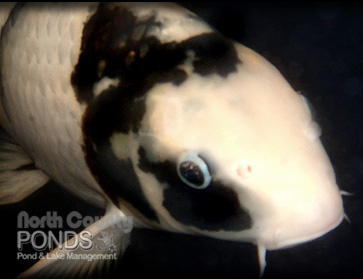 |
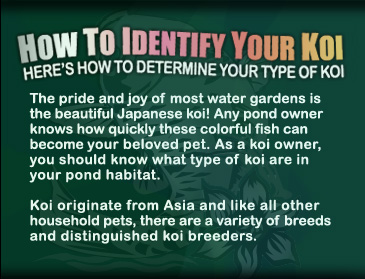 |
 |
|
|
 |
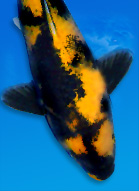 |
 |
| Ki Utsuri is a very old variety traceable back to 1875, at the beginning of the Meiji Era. Eizaburo Hoshino, who was also responsible for improving Sanke bloodlines in the early twentieth century, coined the term "Ki Utsuri" for this yellow and black koi. Before this, they were earlier known as Kuro-Ki-Han. Head patterning of Ki Utsuri can range from the classic lightening strike or V-shape shared with Showa, to relatively small counterpoints on the yellow skin. These don't have to be symmetrical, but t Kohakus are a must for every koi fish pond. Probably the most common of the Japanese koi. |
 |
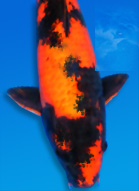 |
 |
| Hi Utsuri are best viewed as a Showa without the white. Until recent years, the hi was rarely scarlet, but out crossings with Kohaku have greatly improved upon this variety. Some breeders have also reintroduced Magoi genes into their strain of Hi Utsuri, which allows the koi to attain a greater size without any falloff in pattern or skin quality. the pectorals rarely s the edges should be clearly defined. Too much black on the head, makes for an inferior koi. |
 |
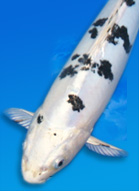 |
 |
| About 30 years ago, when koi keeping began to take off outside of Japan, the Bekko variety was quite fashionable, but like most fads, the popularity of this koi diminished over time. Though they may be hard to find, good specimens are truly stunning in their simplicity. Out of the three types of koi that are recognized as Bekko, only one - the Shiro Bekko - is widely known. Shiro Bekko is a Sanke derivative. Although they are still produced from parent fish of this variety, they are just as likely to be seen from spawnings of Sanke, especially Tancho Sanke. Bear in mind that any hi at all on a Shiro Bekko, even on the lips, technically makes it a Sanke. |
 |
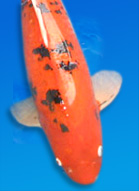 |
 |
| Aka Bekko, never to be referred to as Hi Bekko, are red koi with Bekko sumi markings. Ideally, the body of Aka Bekko should be a scarlet red hi, overlain with deep sumi and offset with pure white or clear finnage. The only koi likely to be confused with Aka Bekko are Aka Sanke; the singular difference being that Aka Sanke show white areas on the body when viewed from above. Aka Bekko are allowed some hi in the finnage, which tends to appear in blotches rather than stripes, although pure white pectoral fins are most pleasing.kin is visible when the koi is viewed from above, the koi is a Showa. Another one of our favorite koi fish. |
 |
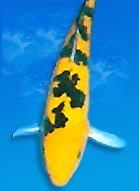 |
 |
| Ki Bekko are the rarest koi in the Bekko group. The Ki Bekko sport a lemon-yellow body overlain with the black sumi. They are not a variety deliberately spawned, but may arise from Shiro Bekko, Kigoi or Sanke crosses. Curiously, the metallic equivalent of a Ki Bekko (known as a Tora, Tiger, or Ogon) is quite commonly seen.audal fins are allowed some sumi, but again, if there is too much, the koi will appear unbalanced. Beautiful, rare koi fish. Their white fins against it’s yellow body is a brilliant contrast. |
|
|
|
 |
| If your pond is new or old, large or small, North County Ponds is trained in a variety of pond care services including regular pond maintenance, on-call pond services, pond clean-outs, complete filter system installs, pond water treatments, system cleanings, pond sealing, koi medicating, koi and fish care, algae control, aquatic plant care, and all other aspects of pond and lake management. Call North County Ponds at 760-710-1632 for questions, pricing info, or to schedule a free pond consultation. |
 |
|
| Cardiff pond maintenance, Carlsbad pond maintenance, Carmel Valley pond maintenance, Del Mar pond maintenance, Encinitas pond maintenance, La Costa pond maintenance, LaJolla pond maintenance, Leucadia pond maintenance, North County pond maintenance, Point Loma pond maintenance, Poway pond maintenance, Rancho Santa Fe pond maintenance, San Diego pond maintenance, and San Marcos pond Maintenance. North County Ponds and Rancho Santa Fe pond service. North County Ponds 760-710-1632 P.O. Box 8053 Rancho Santa Fe, California 92067. North County Ponds is north San Diego's best pond cleaning and pond maintenance service pond cleaning service. For a clean, healthy, beautiful pond, our pond maintenance is second to none. We are pond service professionals and are passionate about clean, healthy koi ponds. Let North County Ponds care for your koi pond. Keep your pond beautiful! Call us today for a free pond consultation: North County Ponds (760-710-1632) Dirty pond? North County Ponds is the answer for clearer, cleaner pond water, pond muck removal, aquatic plant management, pond algae control, pond filter and pond pump maintenance, pond equipment installation, koi health, pond health, and general pond and lake management. North County Ponds services the greater area of north San Diego county including: Rancho Santa Fe ponds, Del Mar ponds, La Jolla ponds, Carmel Valley ponds, Solana Beach ponds, Encinitas ponds, Carlsbad ponds, and Fallbrook ponds. |








